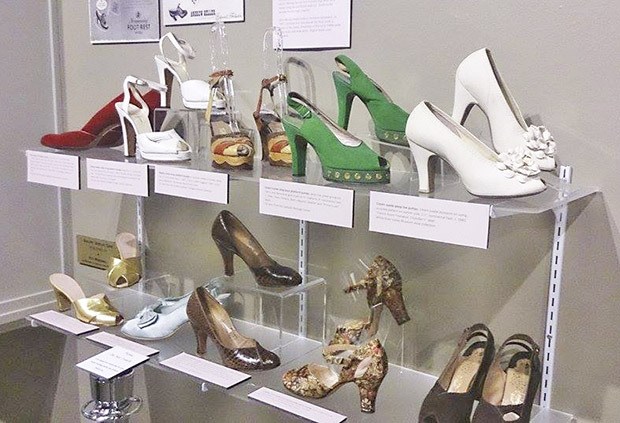By Jacky Graham
For the Auburn Reporter
The White River Valley Museum’s latest exhibit, “Sole Obsession: 100 Years of Women’s Shoes from Kitten Heels to Power Pumps,” features a variety of shoes from 1910 to 2010.
More than 100 pairs of shoes are displayed, representing the evolving changes by the women who wore them.
Pam Salsman, the docent who answered visitors’ questions about the vintage collection, said shoes are an important part of women’s history.
“They made a statement about one’s position in the community – in life, “ she said.
A small description appears with each pair of shoes. For example, stilettos are explained as “covered with rhinestones, ankle strap 2-inch platforms, 6½ stiletto heel, 2013, Steven Madden label.” Rachael McAlister, a museum staff member, wore them at her wedding.
Most of the shoes are fashion-forward for their time but also represent the history of their era. Each decade has a separate shelf of 10 different pairs of shoes.
“Shoes used to be a fashion accessory. They aren’t so much anymore because at one time shoes were a big part of the way women dressed up,” Salsman said.
David Johnson was among the many intrigued visitors.
“As a guy, we maybe have a few styles of shoes, and coming here seeing literally a giant variety of shoes is quite amazing,” Johnson said. “Women have been constantly changing their styles and continuously keeping up with fashion. How do they do it?”
Christine Palmer is the collection’s curator.
Donors are: McAlister; the Eastside Heritage Center; Dana Heston; Mary Kay Lewis; Kaye Ostgard; the Renton History Museum; Seattle Children’s Hospital Bargain Boutique Fashion Collections; Seattle Goodwill Vintage Fashion Collection; Lorraine Weeks; and Lynn Gough.
Gough, of Supercalifragilistic Vintage Fashion Shows, has a distinct passion for historical items and has visited the exhibit several times. She is a member of the Seattle Vintage Clothing and Textile Club, a group that meets monthly to discuss all things vintage. She donated shoes to the exhibit as a way of giving back to the community.
“I was willing to loan a number of my shoes because when they are not in use, they are sitting on a shelf,” Gough said. “People might as well enjoy them and experience the life of women years ago.”
For Gough, shoes are a magical part of educating people.
“From my fashion shows, people tell me they learn so much from my shoes. I don’t want my collection to own me, but be a part of everybody. It is a living museum,” Gough said.
One interesting part of the exhibit – seeing yesterday’s styles reborn as today’s trends. For instance, open-toe shoes that were popular in the 1930s are again in style today.
“I always try to tell people styles recycle,” Salsman said.
Johnson agreed.
“I can definitely see some trends that women enjoy wearing today from back in the day, such as the open-toe shoes that are still trendy,” she said.
Gough said the exhibit is compelling and nicely put together. But she would have preferred less focus on the fashion and more emphasis on the realistic fashion of hard-working women.
“I wish they showed shoes that really reflected the Depression era because that was a very important time to women’s history,” Gough said.
The exhibition continues until Nov. 9 at the museum, 918 H St. SE, Auburn.
For hours, admission and other information, visit www.wrvmuseum.org.


